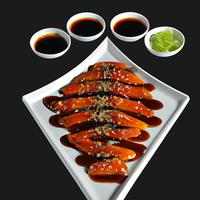
1 serving (150 grams) contains 250 calories, 20.0 grams of protein, 15.0 grams of fat, and 10.0 grams of carbohydrates.

Log this food in SnapCalorie

Nutrition Information
Calories |
394.3 | ||
|---|---|---|---|
% Daily Value* |
|||
| Total Fat | 23.7 g | 30% | |
| Saturated Fat | 4.7 g | 23% | |
| Polyunsaturated Fat | 0 g | ||
| Cholesterol | 78.9 mg | 26% | |
| Sodium | 946.4 mg | 41% | |
| Total Carbohydrates | 15.8 g | 5% | |
| Dietary Fiber | 1.6 g | 5% | |
| Sugars | 3.2 g | ||
| protein | 31.5 g | 63% | |
| Vitamin D | 315.5 mcg | 1577% | |
| Calcium | 47.3 mg | 3% | |
| Iron | 1.6 mg | 8% | |
| Potassium | 473.2 mg | 10% | |
* Percent Daily Values are based on a 2,000 calorie diet. Your daily values may be higher or lower depending on your calorie needs.
Food Attributes
Source of Calories
About Korean fish fillet
Korean Fish Fillet is a savory dish originating from Korean cuisine, celebrated for its crispy texture and balanced flavors. Typically prepared with white fish such as cod or pollock, the fillet is marinated in a blend of soy sauce, garlic, ginger, and sesame oil, which enhances its depth of taste. It's lightly coated in flour or batter and pan-fried or deep-fried until golden brown. This dish is rich in protein, beneficial for muscle repair and growth, while the use of heart-healthy sesame oil adds antioxidants. However, its frying process may increase calorie and fat content, depending on preparation methods. Served with a side of fresh vegetables or steamed rice, Korean Fish Fillet makes for a delightful, flavorful meal. To maximize nutritional benefits, baking or sautéing can be chosen as healthier alternatives to frying.



